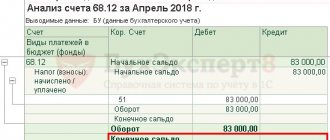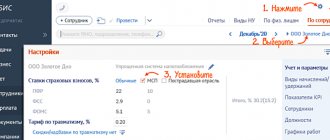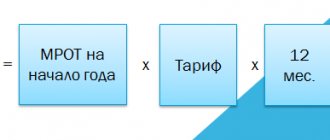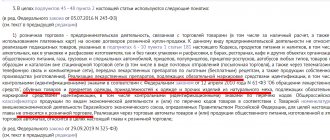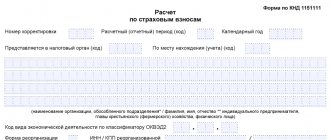What are fixed contributions and why are they no longer fixed?
Fixed contributions were insurance contributions for compulsory pension insurance and compulsory health insurance paid by individual entrepreneurs, lawyers, notaries and other persons engaged in private practice.
Until 2014, defined contributions were truly fixed (set for the year) and the same for all persons paying them. Then amendments to the legislation came into force, changing the procedure for calculating contributions and, in fact, contributions ceased to be fixed, since part of the contributions depends on the income of the entrepreneur.
And from 2021, this name has been removed from regulatory documents. We will continue to call these contributions fixed for convenience and because the name is familiar to entrepreneurs.
Since 2021, the procedure for paying fixed insurance premiums is regulated by Chapter 34 of the Tax Code and contributions are paid not to extra-budgetary funds, but to the territorial tax inspectorates at the place of registration of the individual entrepreneur.
Who pays fixed fees
Contributions in a fixed amount are required to be paid by all individual entrepreneurs, regardless of the taxation system for individual entrepreneurs, business activities and the availability of income. In particular, if an individual entrepreneur works somewhere under an employment contract, and insurance premiums are paid for him by the employer, this is not a basis for exemption from paying contributions calculated in a fixed amount.
Since 2013, you can avoid paying fixed contributions for the following periods:
- conscription service in the army;
- the period of care of one of the parents for each child until he reaches the age of one and a half years, but not more than three years in total;
- the period of care provided by an able-bodied person for a group I disabled person, a disabled child or a person who has reached the age of 80 years;
- the period of residence of spouses of military personnel serving under contract with their spouses in areas where they could not work due to lack of employment opportunities, but not more than five years in total;
- the period of residence abroad of spouses of employees sent to diplomatic missions and consular offices of the Russian Federation, permanent missions of the Russian Federation to international organizations, trade missions of the Russian Federation in foreign countries, representative offices of federal executive authorities, state bodies under federal executive authorities or as representatives these bodies abroad, as well as to representative offices of state institutions of the Russian Federation (state bodies and state institutions of the USSR) abroad and international organizations, the list of which is approved by the Government of the Russian Federation, but not more than five years in total.
However, if entrepreneurial activity was carried out during the above periods, then contributions will have to be paid (clause 7 of Article 430 of the Tax Code of the Russian Federation).
What determines the size of contributions?
Until January 1, 2021, the amount of individual entrepreneur contributions depended on the minimum wage.
However, due to the fact that the minimum wage was increased to the subsistence level, it was decided to “delink” individual entrepreneurs’ contributions from it, and starting from 2021, the fixed amount of contributions paid per year is indicated in the Tax Code.
Since 2014, the amount of fixed contributions also depends on the annual income of the individual entrepreneur, since if the income exceeds 300 thousand rubles during the year. it is necessary to charge another 1% contribution on the amount of income exceeding 300 thousand rubles.
Income is calculated as follows:
- Under OSNO - income accounted for in accordance with Article 210 of the Tax Code of the Russian Federation. i.e. those incomes that are subject to personal income tax (applies only to income received from business activities). When determining these incomes, expenses are taken into account (Resolution of the Constitutional Court of November 30, 2016 No. 27-P);
- Under the simplified tax system with the object of taxation, “income” is income taken into account in accordance with Article 346.15 of the Tax Code of the Russian Federation. Those. those incomes that are taxed under the simplified tax system (such income is indicated in column 4 of the book of income and expenses and is indicated in line 113 of the tax return under the simplified tax system);
- Under the simplified tax system with the object of taxation “income reduced by the amount of expenses” - income taken into account in accordance with Article 346.15 of the Tax Code of the Russian Federation. Those. those incomes that are taxed under the simplified tax system (such income is indicated in column 4 of the book of income and expenses and is indicated in line 213 of the tax return under the simplified tax system). However, there are decisions of courts, including the Supreme Court, that expenses can be taken into account. However, the Ministry of Finance still maintains that all income is taken to calculate contributions.
- Under the Unified Agricultural Tax - income accounted for in accordance with paragraph 1 of Article 346.5 of the Tax Code of the Russian Federation. Those. those incomes that are taxed under the Unified Agricultural Tax (such income is indicated in column 4 of the book of income and expenses and is indicated in line 010 of the tax return under the Unified Agricultural Tax). Expenses are not taken into account when determining income for calculating contributions;
- For UTII - the taxpayer's imputed UTII income, calculated according to the rules of Article 346.26 of the Tax Code of the Russian Federation. Imputed income is indicated in line 100 of section 2 of the UTII declaration. If there are several sections 2, then the income is summed up across all sections. When determining annual income, imputed income from declarations for the 1st-4th quarter is added up.
- With PSN - potential income, calculated according to the rules of Article 346.47 of the Tax Code of the Russian Federation and Article 346.51 of the Tax Code of the Russian Federation. Those. the income from which the cost of the patent is calculated.
- If an individual entrepreneur applies several tax systems at the same time, then the income from them is added up.
Determination of the taxable base
The question of how to correctly calculate the taxable portion of profit for additional contributions to compulsory pension insurance deserves special attention, since under different tax regimes, individual entrepreneurs take into account the income portion differently.
BASIC (general mode)
Individual entrepreneurs who use the general taxation system to calculate the additional insurance premium do not take the entire amount of income, but minus professional deductions, according to clause 3 of Art. 210 of the Tax Code of the Russian Federation (Resolution of the Constitutional Court of November 30, 2016 No. 27-P). This value is indicated in line 060 of section 3 of the 3-NDFL declaration.
Example 1
IP Rubtsov S.A. runs on OSNO. For 2021, he received an income of 700 thousand rubles. The expense taken into account was 200 thousand rubles. He will have to pay 1% of the excess amount on OPS, making the following calculation:
(700 000 – 200 000) – 300 000 = 200 000
1% of 200,000 is equal to 2,000 rubles.
“Mar Ivanovna, I somehow forgot that we add deductions to revenue or subtract them?” Source: freepik.com/user11472009
UTII
“Vmenenka” will cease to exist in 2021. But those who applied for it in 2021 must pay an additional insurance premium by July 1, 2021.
To calculate income, it is not real profit that is taken into account, but imputed income calculated using a special formula. You can take this value from line 100 of the UTII declaration, which is submitted every quarter.
Example 2
Imputed income of individual entrepreneur V.A. Kvasova for 2021 according to declarations amounted to:
- For the 1st quarter – 150,000 rubles.
- For the 2nd quarter – 150,000 rubles.
- For the 3rd quarter – 150,000 rubles.
- For the 4th quarter – 150,000 rubles.
Total for the year – 600,000 rubles.
You will need to pay the settlement portion to the Pension Fund in the amount of 1% x (600,000 – 300,000) = 3,000 rubles.
USN Income
The basis for calculating 1% for pension insurance with a simplified tax system of 6% is considered to be income taken into account in accordance with Art. 346.15 Tax Code of the Russian Federation. This value is reflected in line 113 of section 2.1.1 of the annual declaration under the simplified tax system.
Example 3
IP Gusev A.I. applies the simplified tax system for income. In 2021, he earned 700 thousand rubles. Estimated payments for OPS will be:
- 700,000 – 300,000 = 400,000 – the excess part;
- 1% of 400,000 is equal to 4,000 rubles.
For your information . An individual entrepreneur will be able to reduce his simplified tax not only by the fixed part of contributions, but also by an additional one.
On the topic: is it necessary to conduct KUDIR, on the simplified tax system, 6%.
“Natasha, of course, take it away! I don’t understand how our boss hired you.” Source: freepik.com/kues1
USN Income minus expenses
Until recently, tax authorities insisted that 1% of payments for compulsory pension insurance should be counted on full revenue without taking into account expenses incurred. But on September 1, 2021, the Federal Tax Service in its letter No. BS-4-11/14090 reported that individual entrepreneurs using the simplified tax system “Income minus expenses” to determine the tax base when calculating 1% of pension contributions have the right to reduce income by the amount of expenses provided for in Article 346.16 of the Code . But with one caveat - expenses must relate to the reporting period and the tax base cannot be reduced for losses of previous years.
When calculating the tax base, line 223 of the individual entrepreneur’s declaration on the simplified tax system is subtracted from line 213 of section 2.2.
Example 4
Entrepreneur Maltsev A.A. on the simplified tax system of 15% for 2021, I received income in the amount of 1 million 200 thousand rubles. Expenses amounted to 460 thousand rubles. Additional fees will be:
1,200,000 – 460,000 – 300,000 = 440,000 x 1% = 4,400 rubles.
Patent
To calculate 1% of pension insurance on PSN, the basis is not the actual profit received, but the potential profit, which is involved in calculating the cost of the patent in a given region. It can be taken from line 010 “Tax base” of the appendix to the patent.
Example 5
Entrepreneur Zubov K.D. in 2021 I bought two patents for different types of activities. The tax base in them was indicated in the amount of 360,000 and 280,000 rubles, respectively. Zubov will have to pay additional pension contributions in the amount of:
(360,000 + 280,000 – 300,000) x 1% = 3,400 rubles.
If the patent was issued not for a full year, but for several months, then the tax base will be calculated as follows: the annual potential income is divided by 12 and multiplied by the number of months the patent is valid (Article 346.51 of the Tax Code of the Russian Federation).
Attention! When applying several taxation regimes, taxable income for determining additional contributions is summed up for all types of activities.
Fixed Contribution Tariffs
IN 2020
The following tariffs apply
for payments to individual entrepreneurs “for themselves”
:
| Payers | Pension Fund, insurance part | FFOMS |
| Individual entrepreneurs (regardless of the taxation system), notaries, lawyers and other persons obligated to pay fixed fees | 22.0% (of which 6% is the joint part of the tariff, 16% is individual) | 5.1% |
Why do we need contribution rates if they are not calculated as a percentage of income for individual entrepreneurs? And how many pension points you will be awarded depends on the Pension Fund’s contribution rate.
Calculation of contributions for incomes over 300 thousand rubles
If the income of the payer of insurance premiums for the billing period exceeds 300,000 rubles, in addition to the fixed pension contributions indicated above (32,448 rubles), contributions are paid in the amount of 1% of the income exceeding 300,000 rubles. Note! Health insurance premiums for incomes over 300 thousand rubles are not paid
! Those. The amount of contributions to the FFOMS is fixed for all individual entrepreneurs, regardless of the amount of annual income.
Example:
The income of an individual entrepreneur in 2021 was: 350,000 rubles. for activities subject to the simplified tax system and 100,000 rubles. for activities for which UTII is applied (how income is calculated is indicated above). Total 450,000 rub. The amount of contributions to the Pension Fund for 2021 will be 32,448 + (450,000 − 300,000) × 1% = 33,948 rubles. The amount of contributions to the FFOMS is 8,426 rubles.
The total amount of fixed insurance contributions to the Pension Fund for the year cannot be more than eight times the fixed amount of insurance contributions established for the year. Those. no more than 32,448×8 = 259,584 rubles.
Example:
The income of an individual entrepreneur using the simplified tax system in 2021 was: 30,000,000 rubles. The amount of contributions for 2021 would be 32,448 + (30,000,000 − 300,000) × 1% = 329,448 rubles, however, since it is greater than the maximum possible contributions of 259,584 rubles, 259,584 rubles are paid. contributions to the Pension Fund and contributions to the Federal Compulsory Medical Insurance Fund in the amount of 8,426 rubles.
How much will you have to pay in total?
The legislation sets a limit on the amount of pension payments. The maximum amount should not exceed eight times the size of the fixed part. In 2021, the largest amount of additional contributions may be 227,136 rubles. (32,448 x 8 – 32,448).
Reference. Individual entrepreneurs operating in areas affected by coronavirus were not exempted from paying insurance payments in the amount of 1% of income exceeding 300 thousand rubles. (Letter of the Ministry of Finance No. 03-15-05/105993 dated December 3, 2020).
Who spilled the coffee on the calculator? How to calculate the contribution amount now? Source: freepik.com/mdjaff
Due date for payment of contributions
Insurance premiums for the billing period are paid by individual entrepreneurs no later than December 31 of the current calendar year, with the exception of contributions in the amount of 1% on income exceeding 300 thousand rubles.
Insurance premiums calculated on the amount of income of the payer of insurance premiums exceeding 300,000 rubles for the billing period are paid by the payer of insurance premiums no later than July 1 of the year following the expired billing period.
Contributions (including contributions for compulsory health insurance) are paid from January 1, 2021 not to the Pension Fund, but to the tax office. Including contributions for previous years.
Payment
KBK
Why is the BCC of a regular Pension Fund for exceeding 300 tr.
coincide with 2021? We have been paying for one BCC since 2021 - they are the same (letter of the Ministry of Finance dated 04/07/2017 No. 02-05-10/21007).
KBC are correct here.
From February 22, 2021, a new BCC was introduced for payments over 1% of insurance premiums - 182 1 0210 160 (order No. 255n dated December 27, 2017). However, then it was canceled (order dated February 28, 2018 No. 35n). For the additional percentage, the BCC does not change.
| Payment type | Until 2021 (for any year - 2021, 2015, etc.) | After 2021 (for any year - 2021, 2021, 2021, etc.) |
| Insurance contributions for pension insurance of individual entrepreneurs for themselves in the Pension Fund of the Russian Federation in a fixed amount (based on the minimum wage) | 182 1 0200 160 | 182 1 0210 160 |
| Insurance contributions for pension insurance of individual entrepreneurs for themselves in the Pension Fund of the Russian Federation with income exceeding 300,000 rubles. | 182 1 0200 160 | 182 1 0210 160 |
| Insurance premiums for medical insurance for individual entrepreneurs for themselves in the Federal Compulsory Compulsory Medical Insurance Fund in a fixed amount (based on the minimum wage) | 182 1 0211 160 | 182 1 0213 160 |
How long should payments be kept?
Within 6 years after the end of the year in which the document was last used for calculating contributions and reporting (Clause 6 of Part 2 of Article 28 of the Federal Law dated July 24, 2009 No. 212-FZ) or 5 years (clause 459 Order of the Ministry of Culture of Russia dated August 25 .2010 N 558)
Methods
Attention! Starting from 2021, the new KBK and the new recipient of contributions are not the Pension Fund of Russia, but the Federal Tax Service. Even contributions for December must be transferred according to the new BCC to the Federal Tax Service (except for contributions to the Social Insurance Fund for injuries). Here you can find out the details of your Federal Tax Service.
There are four ways:
- Through Sberbank in cash. Completed three Sberbank pension receipts (xls). PF data must be taken from their payment slips. Then you need to provide copies of receipts to the pension fund.
- If you have a bank account, then you can use it for Samples of payment orders for 2016-2017 and the Free Business Pack program to generate them for instructing the bank to make transfers through a bank account.
- Via Internet banking. For example, Tinkoff is one of the most convenient.
- You can combine these methods or use any of them in any order.
Article 113 of the Tax Code of the Russian Federation on the three-year limitation period does not apply to the Pension Fund of the Russian Federation! For such contributions, the requirement for payment is made “no later than three months from the date of discovery of the arrears” (Article 70 of the Tax Code of the Russian Federation). Arrears can be identified for any period. Therefore, keep your bills for the rest of your life.
If I am an individual entrepreneur and at the same time an employee in another organization, can I not pay Pension Fund contributions as an individual entrepreneur?
Contributions will need to be paid both here and there. Taxes and contributions of individual entrepreneurs and employees are in no way connected and there are no benefits.
Can an individual entrepreneur not pay the simplified tax system at all? What income should an individual entrepreneur have?
Yes, this is possible, but only for individual entrepreneurs who do not hire employees on the simplified tax system of 6%. They have the right to make a deduction up to 100%
| Year | Income up to which the simplified tax system tax is 0 rubles. |
| 2020 and 2021 | 681,233 RUR per year / 56,769 RUR per month. |
| 2022 | 720,183 RUR per year / 60,015 RUR per month. |
| 2023 | 764,033 RUR per year / 63,669 RUR per month. |
Those. with an income of 681,233 ₽, the 6% simplified tax system will be 40,874 ₽, as is the amount of the individual entrepreneur’s contribution. Therefore, you can make a deduction and the tax will be 0 rubles for any individual entrepreneur’s income of 681,233 rubles or less.
With such income or less, an individual entrepreneur without employees is always more profitable than the simplified tax system, because then the tax is simply not paid. Unlike OSNO, UTII, PSN.
Return
You can return the funds if:
- Paid more by mistake
- If you were given the maximum for a failed return
- If you did not take into account expenses under OSNO and simplified tax system, income and expenses
See return application

